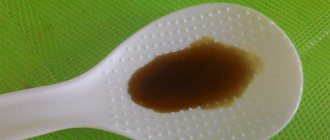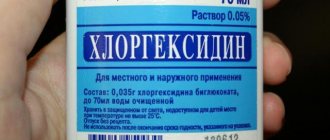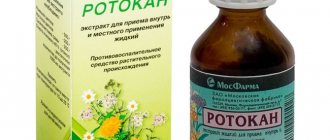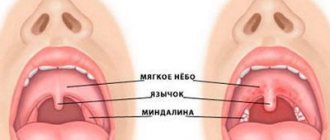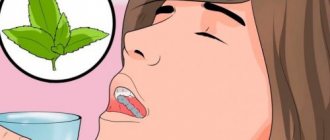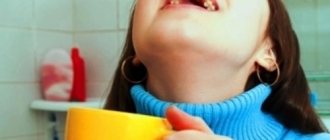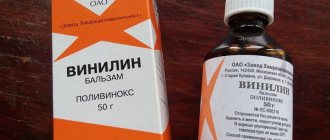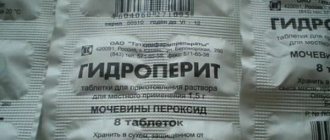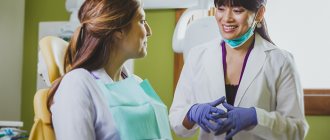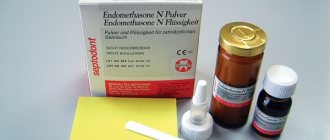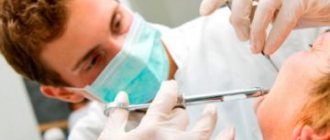Composition of the drug and release form
Rotokan is produced from several medicinal herbs in the form of a dark brown liquid with an orange tint and a specific aroma. Plant extracts are obtained using a solution of alcohol in water.
Rotokan contains extracts:
- chamomile - 2 parts;
- calendula officinalis - 1 part;
- common yarrow - 1 part.
Rotokan solution contains tannins, quercetin, chamazulene, B vitamins and others. Ethanol enhances the antiseptic, anti-inflammatory, and analgesic effects of plants.
The release form of the drug is a liquid extract intended for topical use and oral use. The solution is contained in brown glass dropper bottles or jars (for hospitals) of 25, 50, 90, 100 and 110 ml.
Compound
- Chamomile flower extract (Chamomillae recutitae floridis extract) – 2 parts.
- Calendula officinalis floridis extract (Calendulae officinalis floridis extract) – 1 part.
- Yarrow herb extract (Achillea millefolii herbae extract) – 1 part.
pharmaceutical camomile
Chamomile flowers contain active compounds dioxycoumarins, umbelliferone, salicylic and ascorbic acids, choline, bitterness, mucus, and gums. Heating forms chamazulene.
Chamomile essential oil contains sesquiterpenes, alpha-bisabolol, caprylic and isovaleric acids. The combination with chamazulene has an anti-inflammatory and disinfectant effect.
Chamomile extract accelerates healing, disinfects, has a mild analgesic effect, and eliminates spasm - the cause of pain.
Calendula officinalis
The healing properties are due to carotenoids and flavonoids. Contains polysaccharides, polyphenols, nitrogen-containing mucilage, ascorbic and malic acids.
Calendula accelerates the healing of aphthae - small ulcerations of the mucous membrane, accelerates epithelization and the formation of a shallow scar. It has an anti-inflammatory effect, suppresses the herpes virus and some influenza viruses.
Yarrow
The plant contains polysaccharides, tannins, isovaleric, acetic and formic acids.
The hemostatic effect is due to vitamin K and achillein included in the composition. The mechanism for stopping bleeding is based on increasing the number of platelets without the risk of blood clots.
Yarrow helps lower blood pressure. Strengthens the walls of blood vessels, which prevents varicose veins.
It has choleretic, anti-inflammatory, antibacterial, hypoallergenic, anti-burn effects. Increases immunity.
Medicinal properties
Rotokan has a complex effect. The combination of bioactive plant substances provides the therapeutic effects of Rotokan in dental and ENT practice.
Chamomile ingredients have anti-inflammatory, analgesic and antispasmodic effects. Azulenes in the raw material have anti-allergenic and bacteriostatic effects. Calendula enhances the antimicrobial and other properties of the drug.
Herbal phytoncides are destructive to pathogenic microorganisms. Lycopene and carotenoids have an antioxidant effect, that is, they prevent cell destruction due to free radical attack.
Rotokan has local hemostatic and healing effects due to flavonoids, terpenoids and tannins of yarrow.
The medicinal components in the composition help stop bleeding in the oral cavity. The mechanism of action of the drug is aimed at accelerating blood clotting and reducing blood flow in the affected area of the mucosa.
Indications
Rotocan in dentistry and ENT practice is used for inflammation of various etiologies. The causes of pain, swelling, and bleeding of the mucous membrane are microbes and damage, including burns.
Rotokan for stomatitis acts on fungal and bacterial infections. The remedy is more effective at the initial stage of the disease.
Indications for the use of Rotokan for dental diseases:
- aphthous and erosive stomatitis in the form of ulcerative lesions of the mucous membranes of the lips and cheeks;
- ulcerative necrotizing gingivostomatitis;
- infection of dental alveoli;
- periodontitis;
- periodontal disease;
- gingivitis.
The drug is used for rinsing for diseases of the tongue, pharynx and larynx. The herbal remedy reduces the manifestations of the inflammatory process during glossitis, pharyngitis, and tonsillitis.
Treatment with Rotokan alone is less effective than a combination of rinsing with a solution and using other medications and folk remedies.
The use of Rotokan internally helps with the following problems of the digestive tract:
- gastritis with low acidity of gastric contents;
- enterocolitis of various origins;
- chronic enteritis and colitis;
- functional dyspepsia;
- gastroduodenitis.
In gastroenterology, the drug is prescribed as part of complex therapy. In addition to ingesting the solution, it is necessary to take antispasmodics, enzyme and other drugs, and follow a diet.
Dilution of "Rotokan" for gargling
How to dilute Rotokan for gargling?
- Add 1 tsp. into a glass of warm boiled water (up to +35..+40C).
If well tolerated, the dose can be increased to 3 tsp per glass of water.
Pharyngitis, tonsillitis, tracheitis, bronchitis, rhinitis (with ARVI). Diluted Rotokan is prescribed for gargling and in the form of inhalations.
The drug is used to prevent colds and strengthen the immune system.
Stomatitis, gingivitis. An aqueous solution of “Rotokan” is used on cotton swabs (up to 20 minutes) or held in the mouth for 1-2 minutes 2-3 times a day. Duration of treatment is 2-5 days.
Gastritis with low acidity, chronic colitis and enteritis, gastroduodenitis, cholecystitis. Use "Rotokan":
- Drink an aqueous solution 3-4 times a day, 1/3 cup, half an hour before meals or 40-60 minutes after meals. Duration of treatment is 2-3 weeks.
The solution is applied to burns, acne, to improve the condition of aging skin.
What is rotokan used for?
The drug helps reduce pain during inflammation of the mucous surfaces of the upper respiratory tract, stomach, and rectum. Thanks to the use of the solution, the risk of purulent complications is reduced. Epithelization of the mucous membrane occurs faster.
What does Rotokan help with dental diseases:
- bleeding during tooth extraction;
- damage to the mucosa;
- oral infection;
- painful sensations.
Not all areas of application are described in the official instructions for the drug, since it was created and tested only for certain groups of diseases. During the use of the product, new directions appeared.
Rotokan for flux is a good antiseptic for the oral cavity. The solution is convenient to use at home, at work, on the road. Using a herbal preparation allows you to reduce the use of analgesics.
Rotokan for sore throat is a symptomatic remedy that reduces the intensity of local manifestations of the inflammatory process. Rinse should be so that the solution gets onto the mucous membrane of the pharynx and tonsils.
Inflammation in acute tonsillitis occurs in the palatine tonsils. Gargling with Rotokan for a sore throat helps to quickly get rid of discomfort in the throat. The mucous membrane heals faster, the protective properties of the tonsils are restored.
Rotocan for pharyngitis and tracheitis is mainly used for inhalation during the temperature-free period of the disease. The same procedures help ease breathing when you have a runny nose.
Rotokan is used for coughs to better liquefy mucus in the respiratory tract. The components of the plant extract activate the body's defenses (immunity).
Rotokan in gynecology is used for sitz baths. The procedure is prescribed for inflammatory and infectious diseases: thrush, vaginitis, colpitis.
In dermatocosmetology practice, there are methods for using Rotokan for acne and acne, minor skin damage (cuts, abrasions, cracks, ulcers). The product is applied to disinfect and stimulate healing.
Methods and types of use of the product
The drug is recommended for treatment at the initial signs of the disease. Rotokan for gargling is used at the first symptoms of acute respiratory infections, pharyngitis, sore throat:
- itching;
- soreness;
- pain in the throat;
- hoarseness of voice.
Immediately before using the product, prepare its aqueous solution. How to use Rotokan for rinsing your mouth and throat:
- Shake the bottle with the extract.
- Measure out 1 tsp. medicinal liquid.
- Add the medicine to warm water with a volume of 200-250 ml.
- The solution in the cup should have a temperature of 36-37°C.
- First, rinse your mouth with clean water (30 seconds).
- Then rinse with a diluted preparation (1-2 minutes).
- In total, 2-3 procedures are required per day (children over 12 years old) or 4-5 (adults).
If Rotocan for local procedures is well tolerated, increase the amount of the drug to 2-3 spoons per 200 ml. water (for adults).
The method of preparing Rotokan for rinsing gums does not differ from that described above.
The prepared solution is used for applications for diseases of the oral mucosa. Moisten a sterile bandage and apply to the affected area on the inner surface of the cheeks or gums for 15-20 minutes.
Rotokan is used after tooth extraction for periodontal diseases. Thin turundas moistened with a solution of the drug are inserted into the gum pockets or into the hole at the site of the extracted tooth. The duration of exposure is 20 minutes, the frequency of application is 1 time per day. A total of 4-6 procedures are performed.
Rotokan is used for inhalation with a nebulizer for infectious diseases: acute respiratory infections, sore throat, pharyngitis, tracheitis. To prepare the working solution you will need 1/2 tsp. (2.5 ml.) products per 100 ml. saline solution (bought at the pharmacy). Inhalations are performed for 2-7 days while the symptoms of the disease persist.
In gastroenterology, Rotokan is prescribed for oral administration of an aqueous solution:
- 1 tsp. dilute the drug in 200 ml. water.
- Drink half a glass.
Take the drug half an hour before meals 3 to 4 times a day. You can drink the solution 40-60 minutes after eating. The course is from 2 to 3 weeks.
For microenemas for inflammation of the colon, 50-100 ml are used. diluted in water (a teaspoon per glass of water).
Before the procedure, a cleansing enema is performed. Multiplicity 1-2 times a day. Course - up to 6 days.
Rotokan is used in its pure form for the treatment of skin diseases. A cotton swab is moistened with the extract and applied pointwise to acne, pimples, wounds, and abrasions.
If you prepare a solution of 2 tsp. in a partial glass of water, you will get an antiseptic, tonic for oily and combination skin prone to acne.
Rotokan
Rotocan (medicinal marigold flowers (Latin: Caléndula officinális) + chamomile flowers (Latin: Matricāria chamomīlla) + yarrow herb (Latin: Achilléa millefólium) is a three-component herbal medicine that has an anti-inflammatory, antibacterial, hemostatic and reparative (accelerates tissue repair) effect. Used both externally and systemically. Has a healing effect and helps restore the integrity of the mucous membranes. Used mainly for diseases of the oral cavity of inflammatory origin:
• aphthous inflammation of the oral mucosa;
• inflammation of periodontal tissues;
• ulcerative-necrotic inflammation of the oral cavity and gums.
Another area of application of Rotokan is gastroenterology: the drug is included in protocols for the treatment of inflammation of the duodenal mucosa and pyloric zone of the stomach, chronic inflammation of the small intestine, and inflammation of the colon. It has a dosage form of solution. In the treatment of inflammatory diseases of the oral cavity, the drug is diluted in water and applied through applications to the affected areas or oral baths. Frequency of use – 2-3 times a day. The course of treatment is 2-5 days. In the treatment of periodontitis, the drug is instilled using turundas inserted into the recess between the tooth and the gum (i.e.
n. "gum pocket") The procedure is carried out every day for 5-6 days. When used in gastroenterological practice, Rotokan is used half an hour before a meal or the same period of time after it. The frequency of use is 3-4 times a day, the course of treatment is carried out for 2-3 weeks. Another way to administer the drug is into the rectum through an enema. The procedure is preceded by a cleansing enema. The course of treatment in this case is 4-6 days.
Rotocan is a dark brown liquid with a specific odor. The presence of sediment is not a sign of low-quality medicine: before use, the bottle must be shaken to obtain a homogeneous solution. Due to its herbal nature, the drug has virtually no clinically significant side effects. In rare cases, allergic reactions may develop. The only contraindication to the use of Rotokan is individual intolerance to any component (components) of the drug. There have been no cases of overdose with Rotokan, as well as acute poisoning with the drug. Medicines are sold from pharmacies without presenting a doctor's prescription. It is recommended to store Rotokan in a cool (8-15 °C) place, protecting it from direct sunlight.
Contraindications, side effects, overdose
Rotocan is not prescribed to persons who have been diagnosed with individual hypersensitivity to individual components of the extract or to the drug as a whole. Among the ingredients there is ethanol - about 30 ml. in every 100 ml. extract.
- Due to the presence of alcohol, Rotokan contraindications include alcoholism, serious illnesses and brain injuries.
- Rotokan is not prescribed during pregnancy, severe renal and liver failure.
- Age limit is under 18 years of age.
- Rotokan is contraindicated during breastfeeding.
Children's dosages are not indicated in the instructions. Sometimes Rotokan solution is given to children over 12 years of age for rinsing and inhalation, but only after consultation with a pediatrician.
Among the undesirable effects of the drug are allergic reactions in the form of:
- redness;
- itchy skin;
- rashes;
- nausea;
- vomiting.
In case of an overdose, dizziness may occur. The symptoms will be similar to those of alcohol intoxication. It is necessary to stop using the extract and rinse the stomach.
Analogues of the drug
The medicine Rotokan is unique in its composition. Among the complete analogues one can name the drug Rotocan Vilar. The product has exactly the same composition and indications.
Other Rotokan analogues differ in their mechanism of action in their composition and in that they are not intended for oral use. This is Miramistin, Chlorhexidine. Rotokan for tonsillitis is replaced with Stomatidin, Iodinol.
Stopangin and Hexoral aerosols and sprays are used for the same diseases. Rotokan for inflammation of the gums and similar problems of the oral cavity is replaced with Maraslavin or Stomatidin.
Compared to almost all of the listed products, Rotokan is 3 times cheaper.
Analogs by mechanism of action for use in gastroenterology: Treatment and prophylactic collection No. 3, Gastroflox herbal tea. Keep in mind that the compositions of the drugs are different, the lists of indications and methods of use will also be different.
